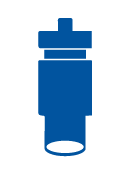Types of Terminals
Posted by Pacer on 3rd Jun 2019
A Look at the Various Types of Terminals, their Advantages, Qualities, and Uses.
*This Article was published on 6/03/2019 and was updated 11/02/2022*

When designing, building, maintaining, repairing, or replacing parts of an electrical system, one crucial component is terminals. Terminals do more than just help transport the current throughout the electrical system. Terminals connect your runs of wire and cable to various pieces of equipment. In doing so, they create solid, secure connections that link your electrical system together. Without terminals, it would be extremely difficult to rely on an electrical system without soldering or using some other, more permanent method. So, you see, electrical connectors offer the flexibility to make changes to your system. Beyond that, the electrical wire connectors rugged construction make it the ideal candidate to handle harsh environments. As if that wasn't enough, they offer long term reliability so you know that your electrical system is going to last even in the toughest environmental conditions out there. One thing some people fail to consider is the importance of selecting the correct terminal. You might be surprised to discover just how crucial it is to have the correct terminal for the job at hand.
The importance of selecting the correct type of terminal for the job cannot be understated. The reason there are so many varying types of terminals is that they are each designed to excel in a given situation or environment. Using the incorrect types of crimp connectors can lead to a simple issue such as loss of performance, or it can lead to catastrophic issues such as fire or engine failure. Knowing how to select the correct electrical connector types is an essential skill. Below we will go over some of the most common types of terminals you are likely to encounter. We’ll discuss the advantages and disadvantages as well as some situations where they are designed to excel. By the end of this article, you should have a firm understanding of the various types of terminals and when to use each one.
"Terminals offer the flexibility to make changes to your system, rugged construction to handle harsh environments, and reliability so you know that your electrical system is going to last."
Ring Terminals
These are probably the most common type of wire connectors you’ll find in a given electrical system and for good reason. Ring terminals offer a solid connection with no chance of slippage or disconnection. Additionally, ring terminals are easy to disconnect if needed. They easily slide over a stud and are locked in place using a nut. Seems simple enough. The truth is that ring terminals are convenient especially if you’re dealing with bus bars or feed-through connectors. There are three things to consider when selecting the correct ring terminal for your job. First, you need to know your wire gauge. Second, you’ll need to know the size of the stud you plan on connecting to and finally, you’ll need to determine what type of insulation is best suited for the environment you will be installing them in. Ring terminals may occasionally need to have the nut tightened, especially in an environment that handles constant vibration. They are ideal you just about any situation and tend to be the more common type of terminal.
Fork Terminals
Fork terminals are similar to ring terminals with the exception that they are designed for easy and quick disconnection. In some situations, you will unable to remove a nut from a stud or have very little room to work in. These are the types of situations where fork terminals excel. Whereas ring terminals need to slide over the stud, fork terminals only need to hug the stud. This means that they can be installed without having to completely remove the nut from a stud. You simply loosen the nut, slide the fork underneath the nut and retighten. This is especially advantageous when a bus bar stud has several wires already attached. This way you won’t need to remove anything to make way for the additional terminals. There are two main varieties of fork terminals; locking forks, and flanged forks.
![]()
Locking Fork
Locking forks carry nubbed ends which snap onto the stud.
That is why they are also known as “snap-on” fork terminals. The nubs create a
space that is smaller than the diameter of the stud they are being attached to.
This means to have to push them past the point of resistance to get them to snap
on. Don’t worry, they are designed for this, and as such the process causes no
damage to the terminal or the stud. This locking action decreases the chances that
they will fall off or come loose over time. Locking forks are a solid choice if you know you may be making changes to the electrical system in the future.
![]()
Flanged fork
Flanged forks do not have the nubs you find on locking forks. Instead, the tips of the forks are turned upwards creating a flange. This flange is designed to grab hold of the nut, holding the fork in
place. The end result is the same in that they hold the fork terminal in place
and decrease the chances of slippage or disconnection. Again, these are a good
choice when you plan to make changes in the future or are working with a stud
that already has several terminals on it. In fact, they are often chosen due to
the fact you can access them without having to disturb any other terminals on
the same stud.
Butt Splices
Butt splices serve a different purpose than the terminals we’ve discussed so far. Where the previous terminals were used to connect wires or cables to equipment, splices are used to connect wires or cables to other wires or cables. You may be asking how that can be useful. Well, what if you need to add a need piece of equipment? Rather than run a whole new wire, you can cut an existing one and use a splice to connect an additional wire to the system. Or perhaps part of a wire was damaged. Instead of replacing the whole twenty-five-foot wire, you can cut out the damaged foot and use splices to add a replacement wire without loss of current or conductivity. Although there are a wide range of splices available, the two most common types are what are considered traditional splices as well as step-down splices. Splices are a type of crimp connector that are easy to use and built for longevity.
![]()
Traditional Splices
As stated above, these connect a wire or cable to other
wires or cables. They are used by inserting a properly stripped wire or cable into
the splice and then crimping them with the proper tool. Now epoxy-lined heat
shrink is slide over the other wire or cable, which we will come back to, and the process is repeated on the other side. Once both sides have been properly inspected, the epoxy-lined heat
shrink is positioned over the splice and, using a heat tool, activated to create a
watertight seal. These are useful terminals when only a section of wire needs
to be replaced or added in.
![]()
This type of butt splice is used when connecting one wire to two or more wires or when connecting wires of different gauges. So, for example, if you needed to connect a 12-gauge wire to a 10-gauge wire, then this would be the best-suited terminal to choose. Additionally, you may need to connect a 10-gauge wire to two 10-gauge wires. Step-down butt splices are built in a range of sizes so that just about any smaller gauge wires can easily be connected. The installation process is the same as mentioned above including the use of epoxy-lined heat shrink. Why is that so important? Epoxy lined heat shrink offers a level of protection you pretty much can't beat.
Disconnects
Sometimes you’re going to need a piece of equipment installed in such a way that it can easily be removed. Or perhaps you just need to be able to service a piece of equipment easily. These are the types of situations that would call for the use of disconnects. Disconnect terminals are designed for field serviceability. That is to say that they are built specifically to be connected, disconnected, and connected again. Can they be used as permanent installation pieces? Of course they can. They are built for long-term use but excel in situations where the connection may need to be broken for maintenance or another, similar purpose. Disconnect terminals come in a wide range of styles in order to meet different demands. Below we will look at the most common and most advantageous types of disconnect terminals.
Many electrical systems are subject to harsh environmental conditions. Conditions that will erode and corrode exposed metals. This will result initially in reduced conductivity, and eventually in electrical failure. The easiest way to prevent this is to use terminals that, when used properly, leave no metal or conductive parts exposed. So, some situations are going to call for the terminals to be field serviceable and resistant to the environment. This is the exact purpose of fully insulated disconnect terminals. They snap together using a tab and tongue system and hold with serious force. These terminals will not come apart easily, otherwise, they would be unable to stand up in a harsh environment.
Partially insulated disconnect terminals have epoxy-lined heat shrink over the barrel while the connector of the terminal is exposed. These are useful in cases where you want to protect the connection but need easy access to the connectors. One of the main advantages of this type of terminal is the ease of access. Snapping together using a tab and tongue method, they are designed to last as permanent connections if needed, or they can be separated to allow for changes. In some situations, these terminals would plug directly into non-insulated piggybacks or similar connectors. You would use this type of terminal in situations where the environment can be somewhat controlled. These are not designed for outdoor or heavy elemental exposure.
Bullet terminals are similar to the types of disconnects mentioned above, however, instead of having a tab and tongue connection method, these use a round knob on the male end and a barrel type terminal on the female end. This allows for easy access to the connection. Essentially, there is little difference between fully insulated disconnects mentioned above and bullet terminals. It really just depends on which one is going to work better for you in a given situation. You may find bullet terminals easier to work within tight spaces.
Piggyback disconnect terminals are designed for use when multiple connections are required to complete a job. To be more specific, they are ideal when there are a limited number of male tabs available. Piggyback terminals are designed to allow another disconnect terminal to be connected to its tab. The connecting tab is located on the back of the piggyback terminal. Once the connection has been made, the piggyback terminal is then connected to the tab of another connector. To put it more simply, piggyback terminals are used to connect to a female connector while accepting a male connector. So, another way of looking at it is that it can be considered a two-way connector.
Many of the disconnect terminals mentioned above can be used in a variety of situations. Pin terminals, however, have a very specific purpose. When you’re working with compression-type terminal blocks, the entry point is only large enough for the wire to fit into. Once the wire is inserted, the screw is tightened putting pressure onto the wire. The problem occurs when you’re using stranded wire. Solid wire will hold together, while stranded wire will separate which can result in loss of conductivity or even damage to your conductors. How do you solve this? By using pin terminals. Essentially, pin terminals change the end of a stranded wire into a solid wire. This way you remove the risk of damage from connecting to a compression-type terminal block while keeping the flexibility of stranded wire.
Environmentally Sealed Connectors
![]()
This family of connectors is designed to create water-tight connections and handle the toughest environmental conditions available. They are designed for cable to cable applications and are built to be plug and play. What that means is that environmentally sealed connectors can easily connect or disconnect an entire harness. So rather than wiring in a harness one wire at a time, you can have the harness built separate and wire in a few connectors. This way all you’ll need to do is simply plug in the harness rather than individual wiring. Below we will briefly discuss some of the more popular lines of environmentally sealed connectors.

DTM
The DTM series of environmentally sealed connectors was
designed specifically to handle lower amperage needs. Each size 20 contact
(24-20 AWG) is built to handle a 7.5 amp continuous capacity. A simple way to
think about this type of environmentally sealed connector is to remember that
the "m" means "mini". You get smaller connectors to handle
lower amperage needs. Now, just because they have a smaller size, that does not
take away from their durability. DTM series connectors are equally durable to
the other lines of environmentally sealed connectors we’ll discuss.

DT
You can think of these as the standard size
environmentally sealed connectors. Built specifically to handle tough
environments, this style was designed so that each size 16 contact (20-14 AWG)
can handle 13 amp continuous capacity. Just a few of the advantages of these connectors
are; rugged design, field serviceability, and longevity. Remember, that even
though these are built to handle tough environments, they are also built for
ease of access making them ideal for a multitude of industrial applications.

DTP
Whereas the DTM and DT series are designed to handle smaller and
standard applications respectively, the DTP line is built to handle the most
demanding power requirements. You can think the “p” as relating to power as
these connectors offer continuous 25-amp service to each circuit. These are the
larger of the family and offer rugged durability and longevity. One aspect to
pay attention to is the gauge of your wire. DTP is designed for use with
specific sizes of wire. They are built to work well with 14 to 10 gauge wires.

The last type of environmentally sealed connectors we’ll look at is also the strongest. These connectors are single cavity usage and are designed for heavy-duty applications. This is why they are “HD”. For use with 10 gauge or 6 gauge wire, these are the toughest of the tough. With these rugged connectors, your circuit can easily handle 60 or 100 amps of continuous power. They offer all of the benefits of the other types mentioned above with added durability.
Lugs
Lugs are very similar ring terminals we mentioned above. There are two main differences, however. First, lugs are designed more for cable than wire. Lugs are larger so they handle a larger diameter cable or occasionally wire. The second difference is the body. The bodies are shaped differently and built to be much more durable than ring terminals. They have to be. They are handling more weight and more current. With ring terminals, you can get several different insulation options. Lugs are only available in a few insulation types. Below we’ll take a look at two of the most common types of lugs.
![]()
Closed-End
Closed-end lugs are built to be the most durable and
long-lasting option. As the name implies, the end is closed. The closed-end
prevents any form of environmental intrusion whatsoever from the end of the
terminal. With no exposed connectors, the longevity of the connection is
enhanced. They are tin-plated which helps to reduce the chances of corrosion
setting in. Additionally, closed end lugs meet a range of compliances and
standards. These things add up to create a high-quality terminal ideal for use
in marine environments.
![]()
Brazed Seam
The whole point of terminals is to create a solid,
lasting electrical connection. Brazed seam tinned lugs achieve that by being
easy to use and install. Just like the closed-end lugs, brazed seam lugs are
built thicker than ring terminals to handle the extra weight and conductivity.
They are also tinned which, again, helps to reduce the chances of corrosion. They
are meant for use in situations that do not require high levels of
environmental protection. If needed, they can be covered with epoxy-lined heat
shrink in order to enhance their level of resistance.
Coaxial Connectors
This type of connector is much more varied in appearance and application than the other types of connectors we have looked at. Coaxial connectors are a type of radio-frequency connector commonly found in the audio, video, RF, digital, and microwave industries. So you see, with such a broad range of applications, the terminals need to be varied to meet the demands of each application. Some coax connectors can simply be screwed on while others may need specific compression tools.
BNC Connectors
BNC series connectors are designed for quick and easy connecting and disconnecting. They are built with a positive locking mechanism that achieves connector mating with a simple quarter turn of the coupling nut. Built from brass and zinc, and using gold as the contact material, BNC connectors ensure not only high conductivity but longevity as well. These are a common choice due to the ease of installation and simplicity in usage.
These are the connectors you’re familiar with if you’ve ever hooked up a cable box to the back of a television. They are the most common type of coaxial cable connector used in household applications. They are built to simply screw into the mating unit creating a solid connection. Female connectors are built for use with either RG59 or RG6 coaxial cables. Although there are some that can be simply pushed on, the best option is the screw-type. This way you know you made a solid connection and that your wire will not come loose
Connectors can be thought of as extenders. Say you need to run a length of cable 30 feet, but you only have two 15 feet lengths. That’s where you would use an F-to-F or J-to-J connector in order to link the two 15-foot cables into one. F-to-F is for use with the female connectors above while the J-to-J connector is for use with UHF connectors we’ll talk about further down. These, again, are a popular choice due to the ease of installation. They simply screw into the end of the cables you want to connect, and you're done.
Reducers
In some cases, you’ll need to connect a smaller wire to a
larger connector in order to allow it to connect to specific equipment. A
reducer is designed to fill that gap with a highly conductive metal. Essentially,
it’s a buffer that fits snuggly between the wire and the connector. They slide
over the wire before termination occurs and screw into the base of the
terminal. They are so easy to use that it literally takes about 10 seconds to install a reducer.
UHF Connectors
This type of coaxial connector is for RG8, RG11, RG213, RG214, and LMR-400 cables. It was originally meant for video use in radar
applications. Currently, it is commonly used in very high-frequency radio
applications. Its threaded design allows it to be easily connected and
disconnected to various pieces of equipment as needed. This type of connector
requires basic soldering skills and is not meant for long-term outdoor usage. One major benefit of this type of connector is its rugged durability. It can easily handle minor abrasion and impacts.
Battery posts
Battery posts are used to connect a load to a battery. They are electrical contacts that can be used with a single cell or multi-celled batteries. All Pacer battery post terminals are built with 131 contact copper. This type of copper is 95% pure, offering high conductivity. Each one is electro-plated with tin which makes it ideal for harsh marine environments. To install, you simply loosen the nut, slide the battery terminal over the post, and then tighten the nut securing the battery terminal into place. Additionally, you will want to consider adding a boot for an extra level of protection. There are four different options for battery posts depending on your needs.




Ferrules
Wire ferrules are used when connecting a stranded wire to a terminal block. The intent behind these terminals is to prevent wire fraying. In cases where you're using stranded wire, the tightening screw on the terminal block would separate and damage your wire. The ferrule encases the wire and prevents any damage. It also creates a stronger connection which ensures the life of your connection. Think about it. Just putting a stranded wire into a European terminal block and then tightening the screw will definitely separate the wires. Wire ferrules are easy to install. All they need is a simple crimp, and you're done.
Bonus: Terminal Kits
Having all the terminals you need in one convenient place makes getting the job done a quicker and easier task. Pacer's terminal kits come with an assortment of ring terminals and butt splices. To make this even better, the portable carrying case is built to last and is ideal for field service work. The translucent case makes finding the terminal you need a simple task. Our kits are available in either nylon insulation or epoxy-lined heat shrink insulation.
With so many types of terminals, it's important to know which type of terminal is best suited to meet the demands of your project. Having a general understanding of the various types of terminals and when and where to use them can go a long way. Remember, each type is specifically suited to handle a unique set of conditions and applications. Feel free to bookmark this page as a quick reference and, as always contact a Pacer expert with any questions you may have.




















